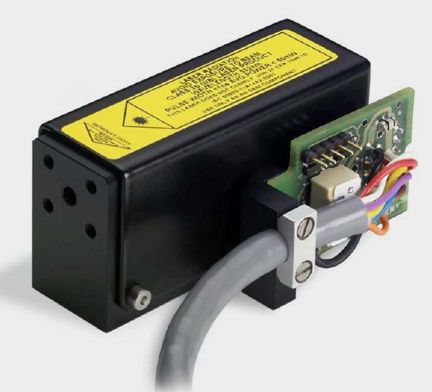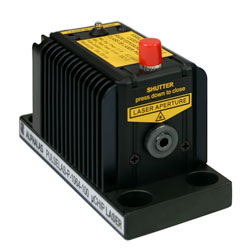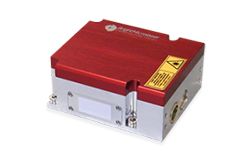monolithic solid-state lasers (original) (raw)
Definition: solid-state lasers where the whole laser resonator consists only of one piece of crystal or glass
Category:  laser devices and laser physics
laser devices and laser physics
- solid-state lasers
- bulk lasers
* rod lasers
* slab lasers
* thin-disk lasers
* monolithic solid-state lasers
* nonplanar ring oscillators
* microchip lasers
* alexandrite lasers
* ruby lasers
* lamp-pumped lasers
- bulk lasers
Related: solid-state lasersmicrochip laserswaveguide lasers
Page views in 12 months: 330
DOI: 10.61835/dfx Cite the article: BibTex BibLaTex plain textHTML Link to this page! LinkedIn
Content quality and neutrality are maintained according to our editorial policy.
📦 For purchasing microchip lasers, use the RP Photonics Buyer's Guide — an expert-curated directory for finding all relevant suppliers, which also offers advanced purchasing assistance.
Contents
Introduction
Although most solid-state lasers consist of a number of discrete elements (e.g. of a laser crystal or glass, some laser mirrors, and possibly additional intracavity optical elements), there are some types of lasers which are monolithic. For monolithic lasers according to a strict definition, the whole laser resonator consists only of some piece of crystal or glass. The resonator is then closed either with dielectric mirror coatings on the surfaces, or with total internal reflection. A somewhat relaxed definition allows for reflections from additional optical elements, and even for additional components within the laser resonator, provided that these elements are rigidly attached (e.g. bonded) to the gain medium.
Normally, one ignores the need for a separate laser diode for pumping, although this makes the complete laser setup clearly non-monolithic.
Types of Monolithic Lasers
There are monolithic lasers of different kinds; some typical examples are listed in the following:
- Microchip lasers have a linear resonator, with the gain medium being a thin slice of crystal or glass material. Such lasers are available as compact single-frequency lasers, also in Q-switched form or with intracavity frequency doubling (→ green lasers).
- Nonplanar ring oscillators (NPROs) are monolithic lasers where the laser radiation circulates along a nonplanar ring in a single laser crystal (e.g. of Nd:YAG). In most cases, these are single-frequency lasers, and they can deliver up to a few watts of output power.
- Waveguide lasers are also often monolithic. Such a laser can be based on, e.g., a channel waveguide in lithium niobate (LiNbO3). The nonlinearity of this material allows for further functions, such as electro-optic modulation for Q-switching, mode locking, or wavelength tuning.
- Fiber lasers might also be called monolithic when all fiber components (for example, a fiber coupler, a gain fiber, a fiber-coupled pump laser diode and two fiber Bragg gratings as end mirrors) are spliced together, such that the laser becomes alignment-free.
- Most semiconductor lasers, e.g. laser diodes, are monolithic.
Typical Properties
A common property of monolithic lasers is that they have a very stable and compact setup. That can be helpful for obtaining stable single-frequency operation, for example, and a low sensitivity to vibrations.
Monolithic laser designs often allow for fairly low intracavity losses (possibly well below 1%), leading to a low threshold pump power and relatively small linewidth (even though carefully designed lasers with longer resonators can have a still narrower linewidth).
Another consequence of the typically short resonator is a high relaxation oscillation frequency. Quantum-limited laser noise performance may thus be achieved only at relatively high noise frequencies.
A practical limitation is that a monolithic laser setup normally does not allow the insertion of additional intracavity optical components (although special designs allow for that [14]). Also, it is usually not possible to modify various design parameters without fabricating a whole new laser device.
Frequently Asked Questions
This FAQ section was generated with AI based on the article content and has been reviewed by the article’s author (RP).
What is a monolithic laser?
A monolithic laser is a device where the entire laser resonator consists of a single piece of crystal or glass. Mirror coatings are often applied directly to the surfaces, or total internal reflection is used. Some designs also have additional components rigidly bonded to the gain medium.
What are common types of monolithic lasers?
What are the main advantages of monolithic lasers?
Monolithic lasers have a very stable and compact setup, making them insensitive to vibrations and well-suited for stable single-frequency operation. They often exhibit low intracavity losses, leading to a low threshold pump power.
Are there disadvantages to monolithic laser designs?
Yes, a practical limitation is that one cannot insert additional optical components into the resonator. Also, design parameters cannot be modified after fabrication without producing a whole new device.
Suppliers
Sponsored content: The RP Photonics Buyer's Guide contains 21 suppliers for microchip lasers. Among them:
⚙ hardware
The SNP-70F microchip laser advanced series reaches 70 kHz pulse repetition rate at 700 ps pulse duration with single longitudinal mode emission.
Teem Photonics offers over 45 short pulse lasers emitting at 1064 nm, or with frequency conversion in the green (532 nm) as well as the ultraviolet at 355 nm, 266 nm and 213 nm at pulse durations down to 100 ps.
⚙ hardware
APS offers microchip lasers emitting at green and infrared wavelengths. For example, the Snake Creek Lasers MicroGreen™ Series is a diode-pumped solid-state laser packaged in a 5.6 mm diameter can — the world’s smallest microchip laser with 532-nm output. An eye-safe version emitting at 1550 nm is also available.
⚙ hardware
Passively Q-switched microchip lasers from ALPHALAS are based on Nd:YAG, Nd:YLF, Yb:YAG and other active media combined with Cr4+:YAG Q-switch. Their monolithic laser cavity is the basis for extreme durability and reliability. Pulse widths range from 500 ps to several nanoseconds. The lasers have high peak powers at the fundamental wavelengths 914, 946, 1030, 1047, 1053, 1064, 1320 or 1342 nm and their harmonics. Models with repetition rates greater than 100 kHz, average power up to 1 W, pulse energies up to 1.5 mJ and > 3 MW peak power directly from an oscillator can be amplified for further power/energy boosting in a MOPA setup. TEM00 beam profile and extremely compact design round up the laser specifications. Applications include material processing, nonlinear optics, efficient Raman Stokes, super continuum generation and micromachining. Customer-specific parameters are also available.
⚙ hardware
Serving North America, RPMC Lasers offers ultra-compact, lightweight, and rugged microchip lasers, versatile enough for space and harsh environments, with easy integration and flexibility to switch models for diverse applications.
These high-efficiency DPSS lasers, the most powerful in their class, deliver precise wavelengths and reliable, low-maintenance performance for 24/7 use, ideal for sensitive tasks requiring stability and accuracy.
Cost-effective and customizable, they come in 28 standard configurations with passive q-switching for a compact, affordable design, maintaining top performance across a wide range of conditions and applications.
Let RPMC help you find the right microchip laser today!
⚙ hardware
LEUKOS offers the passively Q-switched laser HLX-I, a compact microchip laser generated sub-nanosecond pulsed at 1064 nm. Different versions are available, with up to 500 MW average output power. It is suitable for micromachining, a seed laser, for LIDAR, 3 D scanning and imaging, biophotonics, supercontinuum generation and in other fields.
See our data sheet.
Bibliography
| [1] | T. J. Kane and R. L. Byer, “Monolithic, unidirectional single-mode ring laser”, Opt. Lett. 10 (2), 65 (1985); doi:10.1364/OL.10.000065 |
|---|---|
| [2] | K. Wallmeroth, “Monolithic integrated Nd:YAG laser”, Opt. Lett. 15 (16), 903 (1990); doi:10.1364/OL.15.000903 |
| [3] | N. M. Sampas et al., “Long-term stability of two diode-laser-pumped nonplanar ring lasers independently stabilized to two Fabry–Pérot interferometers”, Opt. Lett. 18 (12), 947 (1993); doi:10.1364/OL.18.000947 |
| [4] | S. Zhou et al., “Monolithic self-Q-switched Cr,Nd:YAG laser”, Opt. Lett. 18 (7), 511 (1993); doi:10.1364/OL.18.000511 |
| [5] | I. Freitag et al., “Power scaling of diode-pumped monolithic Nd:YAG lasers to output powers of several watts”, Opt. Commun. 115, 511 (1995); doi:10.1016/0030-4018(95)00020-9 |
| [6] | H. Liu, S. Zhou and Y. C. Chen, “High-power monolithic unstable-resonator solid-state laser”, Opt. Lett. 23 (6), 451 (1998); doi:10.1364/OL.23.000451 |
| [7] | H. Rong et al., “Monolithic integrated Raman silicon laser”, Opt. Express 14 (15), 6705 (2006); doi:10.1364/OE.14.006705 |
| [8] | I. Häggström, B. Jacobsson and F. Laurell, “Monolithic Bragg-locked Nd:GdVO4 laser”, Opt. Express 15 (18), 11589 (2007); doi:10.1364/OE.15.011589 |
| [9] | L. Chrostowski and W. Shi, “Monolithic injection-locked high-speed semiconductor ring lasers”, J. Lightwave Technol. 26 (19), 3355 (2008) |
| [10] | T. D. Shoji et al., “Ultra-low-noise monolithic mode-locked solid-state laser”, Optica 3 (9), 995 (2016); doi:10.1364/OPTICA.3.000995 |
| [11] | J. D. B. Bradley et al., “Monolithic erbium- and ytterbium-doped microring lasers on silicon chips”, Opt. Express 22 (10), 12226 (2014); doi:10.1364/OE.22.012226 |
| [12] | S. Reilly et al., “Monolithic diamond Raman laser”, Opt. Lett. 40 (6), 930 (2015); doi:10.1364/OL.40.000930 |
| [13] | W. Li et al., “151 W monolithic diffraction-limited Yb-doped photonic bandgap fiber laser at ∼978nm”, Opt. Express 27 (18), 24972 (2019); doi:10.1364/OE.27.024972 |
| [14] | H.-Yu Liu et al., “High power single-frequency 1112 nm laser by an insertable Nd:YAG/YAG bonded monolithic planar ring oscillator”, Opt. Express 31 (23), 37597 (2023); doi:10.1364/OE.500304 |
| [15] | M. Lee, P. H. Moriya and J. E. Hastie, “Monolithic VECSEL for stable kHz linewidth”, Opt. Express 31 (23), 38786 (2023); doi:10.1364/OE.490046 |
(Suggest additional literature!)
Questions and Comments from Users
Here you can submit questions and comments. As far as they get accepted by the author, they will appear above this paragraph together with the author’s answer. The author will decide on acceptance based on certain criteria. Essentially, the issue must be of sufficiently broad interest.
Please do not enter personal data here. (See also our privacy declaration.) If you wish to receive personal feedback or consultancy from the author, please contact him, e.g. via e-mail.
By submitting the information, you give your consent to the potential publication of your inputs on our website according to our rules. (If you later retract your consent, we will delete those inputs.) As your inputs are first reviewed by the author, they may be published with some delay.









